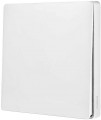Mount
—
In the mounting box. The design of the switch involves hidden (embedded, internal) installation in the wall. After installation, only the button framed by the front decorative panel remains available to the user, and the electrical contact group itself is placed in the mounting box (glass), which, in turn, is fixed in the wall technological connector, from where hidden wiring is output. Recessed switches are good because only the framed button protrudes from the wall. Among the minuses can be noted the complexity of the connection. Additionally, the location of the mounting boxes for switches must be planned at the stage of laying hidden wiring.
—
Outdoor. The switch for outdoor (surface) installation is represented by a sealed housing with a push button, which protrudes significantly above the wall level. The electrical fittings themselves are installed on a mounting plate, which in turn is fixed directly to the wall surface. Outdoor switches are designed to be connected to outdoor wiring. Solutions of this type are especially relevant in those cases when it is necessary to equip a wall partition with a switch, on which it is not possible to embed a mounting box. An important advantage of outdoor switches is the ease of connection and installation. The body of the overhead electrical accessories can be easily disassembled, which allows you to quickly and easily connect the wiring, and to fix th
...e switch, simply screw the mounting plate to the wall / partition.Wireless connection
The switch closes/opens the electrical circuit by sending commands over the radio channel. The vast majority of
wireless switches are represented by a call button. The main advantage of this type of electrical fittings is the possibility of installation without direct connection to current-carrying wiring, which has a positive effect on the aesthetic beauty of the object. Among the shortcomings can be noted the need for regular replacement of the battery pack. When choosing a switch with a wireless connection, it is necessary to check the compatibility of the electrical fittings with the main actuator.
Rated current
The total value of the current strength of consumers that are served by one switch. Before ordering a circuit breaker, it is necessary to calculate the current strength of all consumers. So, for example, one 100 W incandescent bulb, when connected to a 230 V network, has a current strength of 0.45 A. Regarding LED bulbs, an average 12 W LED illuminator consumes only 0.02 A. An average household switch with The plastic housing of the electrocontact group has a nominal current value of 10 A, but there are completely plastic switches with a current of 16 A.
Wire connection
—
Screw. The wiring is fixed to the electrocontact group using screws with a Phillips head or a flat screwdriver. The threaded surface of the screw acts on the pressure plate, which clamps the bare part of the wire. Screw connection of wires is valued for the ability to control the clamping force of the wiring. The main disadvantage of this solution is the spontaneous loosening of the tightening, which occurs due to frequent changes in temperature in the threaded surface. For this reason, leading manufacturers of electrical accessories are beginning to slowly move away from the screw method of connecting wiring.
— Clamp. The wiring is fixed with a spring clip. To insert the wire into the terminal block, it is necessary to lift the lever of the spring clip. The wire is fixed under the force of a stretched spring. The main advantage of a self-clamping connection is the ease of fixing the wires. There is no need to screw in / unscrew the screws, which saves time and effort. Additionally, the spring clamp is not subject to weakening of the fixation due to the high dynamics of the temperature regime. Among the shortcomings, one can single out the inability to control the clamping force of the wiring. Electrical fittings with self-clamping terminals are more expensive than analogs with screw clamps.
Embedding depth
The embedding depth determines how much free space must be in the mounting box in order to correctly place the electrocontact group. The depth of the standard mounting box is 40 mm. This is enough to embed most household switches — the embedding depth of an ordinary average switch is 20-30 mm.
But some models of switches require a greater installation depth. So, there are switches that need from the mounting box up to 60 and even up to 80 mm.

